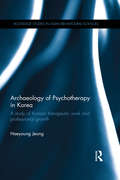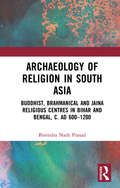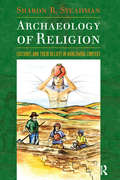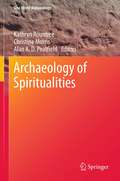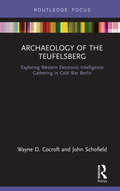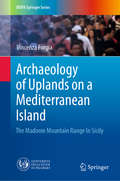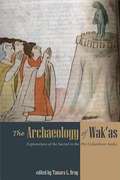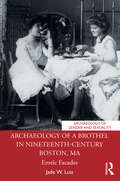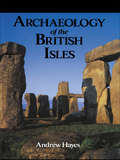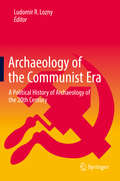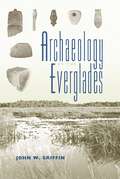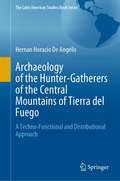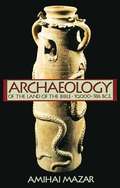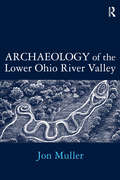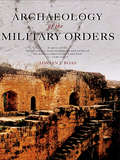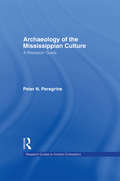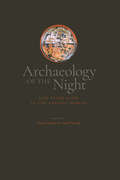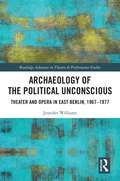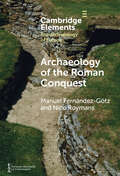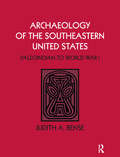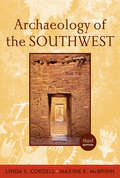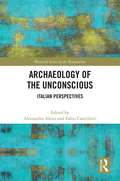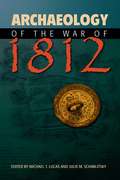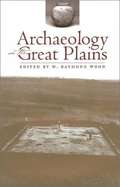- Table View
- List View
Archaeology of Psychotherapy in Korea: A study of Korean therapeutic work and professional growth (Routledge Studies in Asian Behavioural Sciences)
by Haeyoung JeongThis is the first English book dedicated solely to the historical development of psychotherapy in Korea. It is an archaeological research of literature relating to the care and treatment of mind in Korean history in dialogue with spiritual, philosophical, cultural, social, and medical perspectives. It reviews the evolution of different approaches on mental illnesses covering autochthonous practices, psychiatry, clinical psychology, counseling, Western psychotherapy, and Korean psychotherapy. Archaeology of Psychotherapy in Korea inspects: Folk Treatment First Psychiatry Influence from Clinical Psychology Counselling Development Implementation of Western Psychotherapy Shaping of Korean Psychotherapy Its discussion engages firmly with the Korean culture and perspective while acknowledging various extrinsic influences and the fact that Korean psychotherapy continues to evolve in its own unique manner. It aims to refine the understanding of psychotherapy development in Korea in connection with its historical and social backgrounds, and to interpret a way to highlight the culturally relevant psychotherapy that is more suitable as a Korean psychotherapy better attuned to the distinct cultural and societal expectation of Korea.
Archaeology of Religion in South Asia: Buddhist, Brahmanical and Jaina Religious Centres in Bihar and Bengal, c. AD 600–1200
by Birendra Nath PrasadIn the religious landscape of early medieval (c. AD 600-1200) Bihar and Bengal, poly-religiosity was generally the norm than an exception, which entailed the evolution of complex patterns of inter-religious equations. Buddhism, Brahmanism and Jainism not only coexisted but also competed for social patronage, forcing them to enter into complex interactions with social institutions and processes. Through an analysis of the published archaeological data, this work explores some aspects of the social history of Buddhist, Brahmanical and Jaina temples and shrines, and Buddhist stūpas and monasteries in early medieval Bihar and Bengal. This archaeological history of religions questions many ‘established’ textual reconstructions, and enriches our understanding of the complex issue of the decline of Buddhism in this area. Please note: Taylor & Francis does not sell or distribute the Hardback in India, Pakistan, Nepal, Bhutan, Bangladesh and Sri Lanka.
Archaeology of Religion: Cultures and their Beliefs in Worldwide Context
by Sharon R SteadmanSteadman fills an empty niche in the offerings on how archaeology interprets past religions with this useful textbook. The book includes case studies from around the world, from the study of Upper Paleolithic religions and of shamans in foraging societies to formal religious structures in advanced complex societies of Mesopotamia, Egypt, India and the Andes. Steadman also includes key contemporary religions—Christianity, Islam, and Buddhism, among others—to provide an historical and comparative context. This is an ideal text for a archaeology of religion courses and classes that include a significant component on “past religions,” as well as an excellent guide for general readers.
Archaeology of Spiritualities (One World Archaeology)
by Alan A. Peatfield Christine Morris Kathryn RountreeArchaeology of Spiritualties provides a fresh exploration of the interface between archaeology and religion/spirituality. Archaeological approaches to the study of religion have typically, and often unconsciously, drawn on western paradigms, especially Judaeo-Christian (mono)theistic frameworks and academic rationalisations. Archaeologists have rarely reflected on how these approaches have framed and constrained their choices of methodologies, research questions, hypotheses, definitions, interpretations and analyses, and have neglected an important dimension of religion: the human experience of the numinous - the power, presence or experience of the supernatural. Within the religions of many of the world's peoples, sacred experiences - particularly in relation to sacred landscapes and beings connected with those landscapes - are often given greater emphasis, while doctrine and beliefs are relatively less important. Archaeology of Spiritualities asks how such experiences might be discerned in the archaeological record; how do we recognize and investigate 'other' forms of religious or spiritual experience in the remains of the past? The volume opens up a space to explore critically and reflexively the encounter between archaeology and diverse cultural expressions of spirituality. It showcases experiential and experimental methodologies in this area of the discipline, an unconventional approach within the archaeology of religion. Thus Archaeology of Spiritualities offers a unique, timely and innovative contribution, one that is also challenging and stimulating. It is a great resource to archaeologists, historians, religious scholars, and others interested in cultural and religious heritage.
Archaeology of The Teufelsberg: Exploring Western Electronic Intelligence Gathering in Cold War Berlin (Routledge Archaeologies of the Contemporary World)
by John Schofield Wayne D CocroftFor over 50 years, the white radomes of the Teufelsberg have been one of Berlin’s most prominent landmarks. For half of this time the city lay over 100 miles behind an 'Iron Curtain' that divided East from West, and was surrounded by communist East Germany and the densest concentration of Warsaw Pact military forces in Europe. From the vantage point high on the Teufelsberg, British and American personnel constantly monitored the electronic emissions from the surrounding military forces, as well as high-level political intelligence. Today, the Teufelsberg stands as a contemporary and spectacular ruin, representing a significant relic of a lost cyber space of Cold War electronic emissions and espionage. Based on archaeological fieldwork and recently declassified documents, this book presents a new history of the Teufelsberg and other Western intelligence gathering sites in Berlin. At a time when intelligence gathering is once more under close scrutiny, when questions are being asked about the intelligence relationship between the United States and Russia, and amidst wider debate about the US’s National Security Agency (NSA) intelligence programmes, sites like the Teufelsberg raise questions that appear both important and timely.
Archaeology of Uplands on a Mediterranean Island: The Madonie Mountain Range In Sicily (UNIPA Springer Series)
by Vincenza ForgiaThis book presents archaeological research conducted within the Highlands of Sicily. Results of an archaeological survey in the Madonie mountain range, in northern Sicily, supported by a chronological and cultural grid, drawn by the excavation of Vallone Inferno, deal with complex and fascinating problems of uplands and mountainous landscape. Settlement patterns, between the Late Pleistocene and the Medieval era, are investigated through the support of spatial analyses. A diversified use of the mountain is currently attested by this research, according to the different prehistoric and historical times. This work is innovative for the Mediterranean area, where there are no similar examples of such extensive territorial research in a mountainous context. The research has been focused on particular aspects of ancient peopling: economic and social issues, human-environment interactions and the long term interest in the mountain range.
Archaeology of Wak'as
by Tamara L. BrayIn this edited volume, Andean wak'as--idols, statues, sacred places, images, and oratories--play a central role in understanding Andean social philosophies, cosmologies, materialities, temporalities, and constructions of personhood. Top Andean scholars from a variety of disciplines cross regional, theoretical, and material boundaries in their chapters, offering innovative methods and theoretical frameworks for interpreting the cultural particulars of Andean ontologies and notions of the sacred.Wak'as were understood as agentive, nonhuman persons within many Andean communities and were fundamental to conceptions of place, alimentation, fertility, identity, and memory and the political construction of ecology and life cycles. The ethnohistoric record indicates that wak'as were thought to speak, hear, and communicate, both among themselves and with humans. In their capacity as nonhuman persons, they shared familial relations with members of the community, for instance, young women were wed to local wak'as made of stone and wak'as had sons and daughters who were identified as the mummified remains of the community's revered ancestors.Integrating linguistic, ethnohistoric, ethnographic, and archaeological data, The Archaeology of Wak'as advances our understanding of the nature and culture of wak'as and contributes to the larger theoretical discussions on the meaning and role of-"the sacred" in ancient contexts.
Archaeology of a Brothel in Nineteenth-Century Boston, MA: Erotic Facades (Archaeology of Gender and Sexuality)
by Jade W. LuizArchaeology of a Brothel in Nineteenth-Century Boston, MA provides an accessible and thought-provoking account of the archaeological understanding of nineteenth-century prostitution in Boston, Massachusetts. The book explores how the practice of nineteenth-century sex work involved a careful construction of fantasy for brothel customers. This fantasy had the potential to provide financial stability and security for the madam of the establishment, if not for the women working for them. Employing theories of embodiment, sexuality, and an archaeology of the senses, this study of the Endicott Street collection contributes a new methodological and theoretical framework for studying the archaeology of prostitution across time, space, and culture. The material culture recovered from brothel sites allows exploration of both the semi-private, "behind the scenes" narrative of sex work, as well as the semi-public, eroticised "performance space" where patrons were entertained. Few books on the archaeology of sex work exist and this volume will both provide an updated perspective on the history of sex work in Boston in the nineteenth century as well as tie advances in gender and embodiment theories to a compelling case study. The book is for students and scholars of historical archaeology, nineteenth-century urban America, and gender studies. Students studying feminist theory and archaeology of the senses will also be interested in the contents.
Archaeology of the British Isles: With A Gazetteer Of Sites In England, Wales, Scotland And Ireland
by Andrew Hayes Mr Andrew HayesThis is a guide to the archaeology of the British Isles, from the Ice Age to the medieval period. Beginning with an introduction to the methods and techniques of modern archaeology, the author moves on to cover the archaeology of the British Isles, dealing with such questions as: when the British Isles were first inhabited; how the great Neolithic monuments were planned and built; and the impact of the Roman Conquest. The guide is completed by a detailed gazetteer of 468 sites that can be visited.
Archaeology of the Communist Era: A Political History of Archaeology of the 20th Century
by Ludomir R LoznyThis book contributes to better recognition and comprehension of the interconnection between archaeology and political pressure, especially imposed by the totalitarian communist regimes. It explains why, under such political conditions, some archaeological reasoning and practices were resilient, while new ideas leisurely penetrated the local scenes. It attempts to critically evaluate the political context and its impact on archaeology during the communist era world wide and contributes to better perception of the relationship between science and politics in general. This book analyzes the pressures inflicted on archaeologists by the overwhelmingly potent political environment, which stimulates archaeological thought and controls the conditions for professional engagement. Included are discussions about the perception of archaeology and its findings by the public.
Archaeology of the Everglades (Florida Museum of Natural History: Ripley P. Bullen Series)
by John W. Griffin Patricia C. Griffin"An important book about a natural World Heritage site that also has a rich human heritage."--American Archaeology "As the only available synthesis of the archaeology of the Everglades, this book fills an important niche."--Choice "Adds immeasurably to our knowledge of South Florida archaeology."--Journal of Field Archaeology "Offers a vivid glimpse into a rich cultural past in an oftentimes misunderstood and overlooked region of our country."--H-Net "Detailed descriptions of archaeological surveys and test excavations dovetail nicely with broader chapters on settlement, subsistence, and social organization. This is a valuable reference work."--SMRC Revista "An extremely important work. . . . John has brought his unprecedented knowledge of the archaeology together with his anthropological and ecological insights, to provide the most thorough synthesis of the predrainage aboriginal use of this area. Now that Congress has mandated the restoration of the Everglades . . . this book will provide researchers as well as the general public with an understanding of what the Everglades were like prior to drainage and how humans utilized this natural wonder."--Randolph J. Widmer, University of Houston Originally prepared as a report for the National Park Service in 1988, Griffin's work places the human occupation of the Everglades within the context of South Florida's unique natural environmental systems. He documents, for the first time, the little known but relatively extensive precolumbian occupation of the interior portion of the region and surveys the material culture of the Glades area. He also provides an account of the evolution of the region's climate and landscape and a history of previous archaeological research in the area and fuses ecological and material evidence into a discussion of the sequence and distribution of cultures, social organization, and lifeways of the Everglades inhabitants. Milanich and Miller have transformed Griffin's report into an accessible, comprehensive overview of Everglades archaeology for specialists and the general public. Management plans have been removed, maps redrawn, and updates added. The result is a synthesis of the archaeology of a region that is taking center stage as various state and federal agencies cooperate to restore the health of this important ecosystem, one of the nation's most renowned natural areas and one that has been designated a World Heritage Site and a Wetland of International Importance. This book will make a key work in Florida archaeology more readily available as a springboard for future research and will also, at last, allow John Griffin's contribution to south Florida archaeology to be more widely appreciated. John W. Griffin, a pioneer in Florida archaeology, was an archaeologist for both the Florida Park Service and the National Park Service (NPS), director of the NPS Southeast Archeological Center in Macon, Georgia, and director of the St. Augustine Preservation Board. Jerald T. Milanich is emeritus professor at the University of Florida/Florida Museum of Natural History and author of numerous books about the native peoples of the Southeast United States. James J. Miller was state archaeologist and chief of Florida’s Bureau of Archaeological Research for twenty years and is now a consultant in heritage planning. A volume in the Florida Museum of Natural History: Ripley P. Bullen Series
Archaeology of the High Plains
by James H. GunnersonThis publication presents an overview of the archaeology of the Central High Plains. The volume provides baseline information about the archaeology of the Bureau of Land Management's (BLM) Canon City [Colorado] District, the U.S.D.A. Forest Service's Regions II and III and the BLM's Albuquerque [New Mexico] District. This work describes the archaeology of portions of five states and represents a large geographic area ranging from the Continental Divide to the plains of Kansas and Nebraska.
Archaeology of the Hunter-Gatherers of the Central Mountains of Tierra del Fuego: A Techno-Functional and Distributional Approach (The Latin American Studies Book Series)
by Hernan Horacio De AngelisThis work book contributes to the knowledge about human settlements in the Isla Grande of Tierra Del Fuego by the hunter-gatherer societies that inhabited the area until the early twentieth century. The central theme is the study of technological organization as an approach to the management strategies of biotic and abiotic resources, as well as the occupation of space, considering the different environments represented in the area and the differential supply of resources. As a general framework, the book proposes instrumental methodologies that allow us to look at the characterization of the social and economic organization of hunter-gatherer societies from the point of view of the analysis of natural resources management, the resources introduced by Europeans and the spatial organization of technical activities.
Archaeology of the Land of the Bible
by Amihai MazarNotes to Reader: I did not read this carefully to correct. I did format the table of contents so it would be readable; put in page breaks, making sure that no first or last lines of the page were missing and that they followed as they should; scanned and put in missing pages and deleted duplicated pages; described some of the illustrations ( descriptions in brackets are mine). I had the spell-check on as I went, so where I found errors I corrected them but actually it was a very good scan. I did nothing with the indices or end-of-chapter notes. I think they're readable as they are-the scanner seems to have validated them--but if anyone reading this book needs anything fixed let me know and I'll get the book. Whoeveer scanned and submitted this book did an excellent job. Cindy-popularplace@yahoo.com
Archaeology of the Lower Ohio River Valley: New World Archaeological Record (New World Archaeological Record Ser.)
by Jon MullerAlthough it has been occupied for as long and possesses a mound-building tradition of considerable scale and interest, Muller contends that the archaeology of the lower Ohio River Valley--from the confluence with the Mississippi to the falls at Louisville, Kentucky - remains less well-known that that of the elaborate mound-building cultures of the upper valley. This study provides a synthesis of archaeological work done in the region, emphasizing population growth and adaptation within an ecological framework in an attempt to explain the area's cultural evolution.
Archaeology of the Military Orders: A Survey of the Urban Centres, Rural Settlements and Castles of the Military Orders in the Latin East (c.1120-1291)
by Adrian BoasFirst Published in 2004. Routledge is an imprint of Taylor & Francis, an informa company.
Archaeology of the Mississippian Culture: A Research Guide (Peoples of the Ancient World)
by Peter N. PeregrineFirst published in 1996. Routledge is an imprint of Taylor & Francis, an informa company.
Archaeology of the Night: Life After Dark in the Ancient World
by Nancy Gonlin & April NowellHow did ancient peoples experience, view, and portray the night? What was it like to live in the past when total nocturnal darkness was the norm? Archaeology of the Night explores the archaeology, anthropology, mythology, iconography, and epigraphy of nocturnal practices and questions the dominant models of daily ancient life. A diverse team of experienced scholars uses a variety of methods and resources to reconstruct how ancient peoples navigated the night and what their associated daily—and nightly—practices were. This collection challenges modern ideas and misconceptions regarding the night and what darkness and night symbolized in the ancient world, and it highlights the inherent research bias in favor of “daytime” archaeology. Numerous case studies from around the world (including Oman, Mesoamerica, Scandinavia, Rome, Great Zimbabwe, Indus Valley, Peru, and Cahokia) illuminate subversive, social, ritual, domestic, and work activities, such as witchcraft, ceremonies, feasting, sleeping, nocturnal agriculture, and much more. Were there artifacts particularly associated with the night? Authors investigate individuals and groups (both real and mythological) who share a special connection to nighttime life. Reconsidering the archaeological record, Archaeology of the Night views sites, artifacts, features, and cultures from a unique perspective. This book is relevant to anthropologists and archaeologists and also to scholars of human geography, history, astronomy, sensory studies, human biology, folklore, and mythology. Contributors: Susan Alt, Anthony F. Aveni, Jane Eva Baxter, Shadreck Chirikure, Minette Church, Jeremy D. Coltman, Margaret Conkey, Tom Dillehay, Christine C. Dixon, Zenobie Garrett, Nancy Gonlin, Kathryn Kamp, Erin Halstad McGuire, Abigail Joy Moffett, Jerry D. Moore, Smiti Nathan, April Nowell, Scott C. Smith, Glenn R. Storey, Meghan Strong, Cynthia Van Gilder, Alexei Vranich, John C. Whittaker, Rita Wright
Archaeology of the Political Unconscious: Theater and Opera in East Berlin, 1967–1977 (ISSN)
by Jennifer WilliamsThis book investigates the aesthetic and political dialectics of East Berlin to argue how its theater and opera stages incited artists to act out, fuel, and resist the troubled construction of political legitimacy.This volume investigates three case studies of how leading East Berlin stages excavated fragmentary materials from Weimar dramatist Bertolt Brecht’s oeuvre and repurposed them for their post‑fascist society: Uta Birnbaum’s 1967 Man Equals Man at the Berliner Ensemble, Joachim Herz’s 1977 Rise and Fall of the City of Mahagonny at the Komische Oper, and Heiner Muller’s own productions of his trailblazing plays. In each instance, reused theatrical artifacts dialectically expressed the contradictions inherent in East German political legitimacy, at once amplifying and critiquing it. Illuminated by original archival research and translations of letters and artistic ephemera published in English for the first time, and engaging with alternative East German feminist epistemologies, this book’s critical investigation of culture and political legitimacy in the shadow of Germany’s fascist past resonates beyond the Iron Curtain into the twenty‑first century. Its final chapter examines how performative artifacts influence the process of political legitimation in more recent history, ranging from Checkpoint Charlie tourism to the January 6, 2021 US insurrection.This study will be of great interest to students and scholars in theater and performance studies, art history, musicology, German studies, anthropology, and political science.
Archaeology of the Roman Conquest: Tracing the Legions, Reclaiming the Conquered (Elements in the Archaeology of Europe)
by Manuel Fernández-Götz Nico RoymansThis Element volume provides an up-to-date synthesis of the archaeology of the Roman conquest, combining new theoretical and methodological approaches with the latest fieldwork results. Recent advances in conflict archaeology research are revolutionising our knowledge of Rome's military campaigns in Western and Central Europe, allowing scholars to reassess the impact of the conquest on the indigenous populations. The volume explores different types of material evidence for the Roman wars of conquest, including temporary camps, battlefields, coinage production, and regional settlement patterns. These and other topics are examined using four case studies: Caesar's Gallic Wars, the Cantabrian and Asturian Wars, the Germanic Wars of Augustus, and the Roman conquest of Britain. By focusing on the 'dark sides' of the Roman expansion and reclaiming the memory of the conquered, the Element aims to contribute to a more holistic understanding of the processes of incorporation and integration into the Roman Empire.
Archaeology of the Southeastern United States: Paleoindian to World War I
by Judith A BenseA chronological summary of major stages in Southeastern United States' development, this unique textbook overviews the region's archaeology from 20,000 years ago to World War I. Early chapters review the history and development of archaeology as a discipline. The following chapters, organized in chronological order, highlight the archaeological characteristics of each featured period. The book's final chapters discuss new directions in Southeastern archaeology, including trends in teaching, research, the business of archaeology, and the public's growing interest. This versatile text perfectly suits undergraduates or anyone requiring a hands-on guide for self-exploration of the fascinating region. This is the first-of-its kind book to summarize Southeastern archaeology. It includes both prehistoric and historic archaeology. Its easy-to-read format is filled with valuable research information. Each chapter is chronologically organized and fully referenced. It has broad audience appeal.
Archaeology of the Southwest: Contact, Commerce, And Change In The U. S. Southwest And Northwestern Mexico (Proceedings Of Sw Symposium Ser.)
by Linda S Cordell Maxine McBrinnThe long-awaited third edition of this well-known textbook continues to be the go-to text and reference for anyone interested in Southwest archaeology. It provides a comprehensive summary of the major themes and topics central to modern interpretation and practice. More concise, accessible, and student-friendly, the Third Edition offers students the latest in current research, debates, and topical syntheses as well as increased coverage of Paleoindian and Archaic periods and the Casas Grandes phenomenon. It remains the perfect text for courses on Southwest archaeology at the advanced undergraduate and graduate levels and is an ideal resource book for the Southwest researchers’ bookshelf and for interested general readers.
Archaeology of the Unconscious: Italian Perspectives (Warwick Series in the Humanities)
by Alessandra Aloisi Fabio CamillettiIn reconstructing the birth and development of the notion of ‘unconscious’, historians of ideas have heavily relied on the Freudian concept of Unbewussten, retroactively projecting the psychoanalytic unconscious over a constellation of diverse cultural experiences taking place in the eighteenth and nineteenth centuries between France and Germany. Archaeology of the Unconscious aims to challenge this perspective by adopting an unusual and thought-provoking viewpoint as the one offered by the Italian case from the 1770s to the immediate aftermath of WWI, when Italo Svevo’s La coscienza di Zeno provides Italy with the first example of a ‘psychoanalytic novel’. Italy’s vibrant culture of the long nineteenth century, characterised by the sedimentation, circulation, intersection, and synergy of different cultural, philosophical, and literary traditions, proves itself to be a privileged object of inquiry for an archaeological study of the unconscious; a study whose object is not the alleged ‘origin’ of a pre-made theoretical construct, but rather the stratifications by which that specific construct was assembled. In line with Michel Foucault’s Archéologie du savoir (1969), this volume will analyze the formation and the circulation, across different authors and texts, of a network of ideas and discourses on interconnected themes, including dreams, memory, recollection, desire, imagination, fantasy, madness, creativity, inspiration, magnetism, and somnambulism. Alongside questioning pre-given narratives of the ‘history of the unconscious’, this book will employ the Italian ‘difference’ as a powerful perspective from whence to address the undeveloped potentialities of the pre-Freudian unconscious, beyond uniquely psychoanalytical viewpoints.
Archaeology of the War of 1812
by Julie M. Schablitsky Michael T. LucasThis is the first summary of how archaeology has contributed to our understanding of the War of 1812. The contributors of original papers discuss recent excavations and field surveys that present an archaeological perspective that enriches,—and often conflicts with, received historical narratives. The studies cover fortifications, encampments, landscapes, shipwrecks, and battles in the midwestern, southern, mid-atlantic, and northeastern regions of the United States and in Canada. In addition to archaeologists, this volume will appeal to military history specialists and other historians.
Archaeology on the Great Plains
by W. Raymond WoodThis book provides a descriptive culture history of human groups on the Great Plains, focusing on that environmental and cultural diversity and on the changing archaeological record." Did you know that the Plains Indians used a complicated sign language as the language of trade, and that they traded with peoples far and near?
